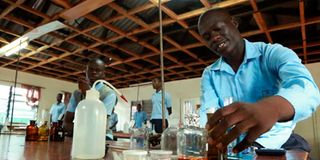Review reagent quantities in the chemistry practical

2020 KCSE candidates at Lions High School, Kisumu, prepare for the chemistry practical paper.
What you need to know:
- There are several possible errors in measuring the solids, considering that the electronic weighing scale has an accuracy error.
- Human error is also a cause of inadequacy in the quantities distributed to candidates; the person measuring the minuscule amounts can make mistakes.
Kenya National Examinations Council (Knec) is the agency responsible for registration and verification of the details of candidates for national examinations, as well as the setting, administration and marking of the exams.
Ahead of the biology, physics and chemistry practical papers, a confidential letter with the requirements is provided to exam centres. The manual should not be shared beyond the subject teacher, laboratory technician and the principal, who facilitates the financing of reagents or apparatus needed.
For instance, to minimise the chances of predicting the content of the Chemistry Practical Paper (Code 233/3), the “Paper 3” exam, the Knec provides special reagents to the exam centre the day before.
Unfortunately, the reagents are the exact volume required for the particular centre. For instance, during the ongoing 2020 KCSE, two reagents – ‘Solid D’ and ‘Solid C’ – were to be measured to 0.3 grammes and 0.5 grammes per candidate for use during the chemistry practical, among other requirements provided from the lab.
But there are several possible errors in measuring the solids, considering that the electronic weighing scale has an accuracy error. Besides, it is not possible to obtain all the solid from the packaging without leaving residues – unless the reagent was required in solution form, which reduces its volume.
Curb cheating
Some of it may remain on the scooping apparatus, say a spatula, leading to a reduction in the quantity. Human error is also a cause of inadequacy in the quantities distributed to candidates; the person measuring the minuscule amounts can make mistakes.
Occasionally, students have misused the reagents, such as when one notices an error in their experiment and would like to repeat it, hence requiring more of the reagent. It is disappointing to the candidate if there is none remaining, causing tension, which could make them to fail the exam.
I suggest that, first, Knec should increase the amount of the reagent at least by 10 percent to cater for disappointments. Secondly, if the reagent were easily available in all levels of schools (exam centres) and also properly identified in the package delivered on exam day, the subject teacher, after consulting with the invigilator, can replace any spilt or misused quantity with that which is in stock in the lab.
Thirdly, in case of an accident as a result of the handling of the reagent, the subject teacher would be able to react from a point of knowledge and avert a disaster. In fact, the candidate could be safer and more confident using the Knec-issue reagent than just being brushed off that no more of it is available.
I agree that the reason no excess solid is provided for the practical exam is to curb cheating. But the inconvenience that providing exact volumes causes the candidates and invigilators is less than the effort required in the vigilance to prevent malpractice. Unless repeating an experiment during a chemistry practical is prohibited, the time for review is now.
Ms Gatobu is a teacher of chemistry and mathematics. [email protected]. @FelicityKatham2





